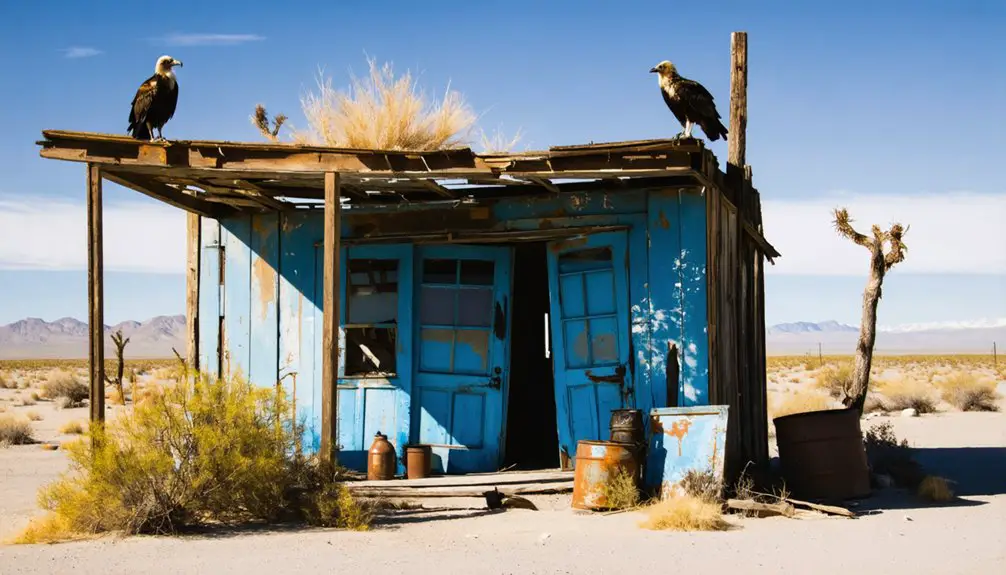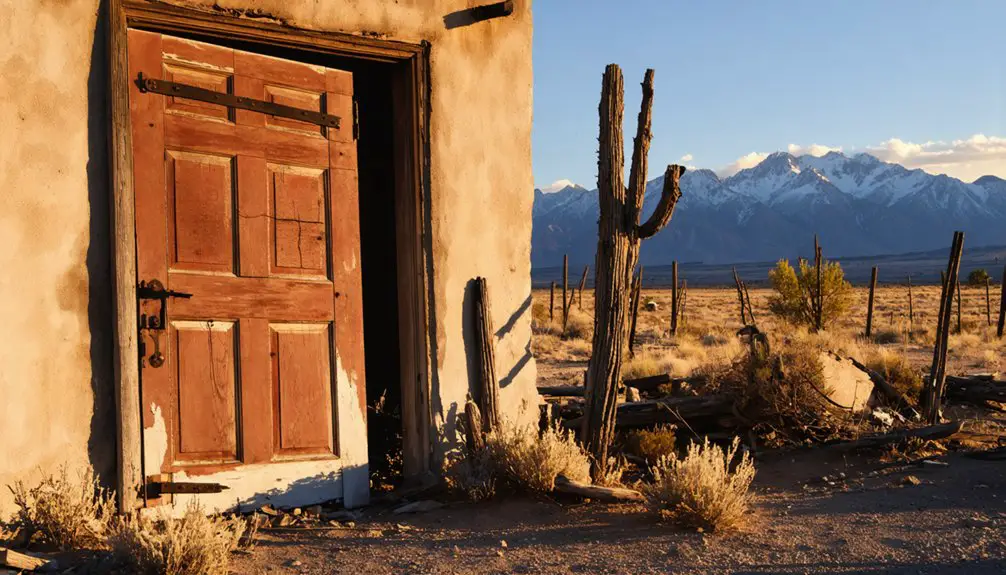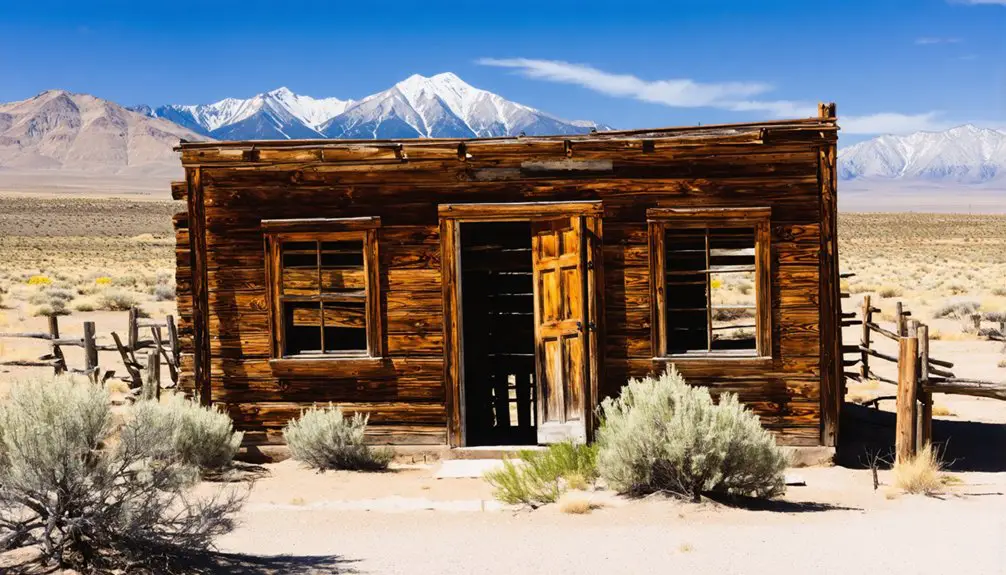You’ll find Woodrow’s remains among Utah’s most compelling ghost towns, where it thrived as a silver mining boomtown from 1869 to the early 1900s. The town peaked at 6,000 residents, supporting 20 saloons and numerous merchants despite its notorious reputation for violence. Today, only scattered foundations and rusted mining equipment mark where this once-bustling community stood. The site’s crumbling infrastructure reveals untold stories of frontier life and the dramatic boom-and-bust cycle of Western mining settlements.
Key Takeaways
- Woodrow was a thriving Utah mining town that peaked at 6,000 residents, driven by silver mining and railroad connections.
- The town featured over 20 saloons, nine grocery stores, and a diverse community of miners, laborers, and entrepreneurs.
- High crime rates led to William Pearson’s appointment as law enforcement, with reports of approximately 50 deaths daily.
- Economic decline began in the late 19th century due to decreased mining profitability and market fluctuations.
- Today, only foundational remnants, mining ruins, and scattered machinery pieces remain as evidence of Woodrow’s existence.
The Rise of a Mining Frontier Town
While the completion of the transcontinental railroad in 1869 catalyzed Utah’s mining boom, Woodrow emerged as a quintessential frontier town shaped by the convergence of geological opportunity and transportation infrastructure.
You’ll find that strategic railroad spur lines connected Woodrow to major smelting hubs, dramatically reducing ore transportation costs and attracting substantial corporate investment. The Park City district nearby experienced similar growth during this era’s silver rush.
Unlike Mormon settlements’ rigid grid patterns, Woodrow’s layout adapted to follow ore veins, reflecting the town’s mining-centric development.
Woodrow’s organic street layout traced the precious mineral deposits below, defying the traditional Mormon city planning of the era.
As mining technology evolved from surface extraction to deep-vein operations, you’d have witnessed remarkable demographic shifts. The town’s population swelled with diverse waves of laborers, prospectors, and entrepreneurs, transforming the once-homogeneous region into a vibrant multicultural community.
The introduction of steam-powered equipment and advanced metallurgy techniques further accelerated Woodrow’s growth as a significant mining center, while the establishment of custom mills in the 1870s revolutionized local ore processing capabilities.
Life in Woodrow’s Glory Days
During its peak in the late 19th century, Woodrow epitomized the untamed nature of America’s western mining towns, as up to 6,000 residents crowded its chaotic streets.
You’d find a diverse mix of miners, families, and drifters creating complex community dynamics amid the town’s 20-plus saloons and numerous brothels. The town faced unique challenges as all water had to be trucked in for the residents.
The transient populations contributed to Woodrow’s notorious reputation, with violence claiming an estimated 50 lives daily during the most lawless periods. The town later brought in William Pearson to combat the rampant crime problem.
Despite the danger, you’d discover nine grocery stores and various merchants serving the bustling community.
While silver mining drove the economy, support industries like charcoal production and blacksmithing flourished.
The town’s rough-and-tumble atmosphere eventually led to the appointment of a sheriff, though Woodrow’s reputation as one of the West’s wildest mining towns endured.
Mining Operations and Economic Impact
The economic engine behind Woodrow’s explosive growth traced back to Colonel Patrick E. Connor‘s arrival in 1862, when his soldiers began prospecting the Wasatch and Oquirrh mountains.
Mining innovations transformed the region, as operations evolved from simple surface prospecting to sophisticated deep mining ventures backed by corporate interests. British investments peaked between 1871-1873, driving significant development in the area.
You’ll find that Woodrow’s development paralleled Utah’s broader economic diversification, shifting from agricultural roots to industrial mining operations.
The arrival of the transcontinental railroad in 1869 proved essential, enabling the transport of ore and attracting substantial financial backing from influential families like the Guggenheims.
The introduction of open-pit mining techniques and advanced processing mills at nearby operations revolutionized the industry’s efficiency. Daniel C. Jackling’s pioneering methods at the Utah Copper Company led to a remarkable achievement where low-grade ore mining became highly profitable.
While this brought prosperity, Woodrow’s fate remained tied to the volatile boom-and-bust cycles that characterized mining towns of the era.
Daily Life and Community Spirit
You’ll find that Woodrow’s residents forged strong social bonds through weekly gatherings and celebrations, including masquerade balls and Thanksgiving events, despite the harsh mining town conditions.
The local saloon and general store served as crucial community hubs where miners could unwind and socialize after long shifts underground. Much like the residents of Saro Gordo mining town, the population of 4,000 people maintained a vibrant social atmosphere despite the challenging environment.
By 1903, the town had grown into a thriving community of over 300 residents who participated in these social activities.
Your examination of historical records reveals how these gatherings provided essential relief from isolation, creating a support network that helped sustain the town’s population through economic ups and downs.
Communal Bonds Despite Hardship
Despite harsh economic conditions and frequent mining accidents, residents of Woodrow forged remarkable bonds of mutual support that defined their daily lives.
You’ll find evidence of communal resilience in the way neighbors regularly assisted each other with mining tasks and construction projects, sharing both labor and resources during difficult times. This neighborly support extended to informal childcare networks and communal firefighting efforts that protected their wooden structures. Using surplus railroad supplies, residents helped each other build and maintain their homes. The care for one another was evident in how they protected graves with iron enclosures to keep loved ones at peace.
Even across racial and cultural boundaries, mixed ethnic communities sometimes cooperated in mining and trading, though social divisions remained.
The community’s determination showed in their maintenance of informal gathering spaces and celebration of shared traditions. Through basic schools, religious groups, and social events, residents cultivated a collective identity that helped them endure the harsh realities of their mining town existence.
Entertainment After Mining Hours
While miners spent long days laboring underground, evening hours in Woodrow offered essential opportunities for social connection and leisure activities. You’d find residents gathering at the schoolhouse or church, where evening gatherings transformed these practical buildings into vibrant social hubs.
Communal meals and potlucks strengthened neighborhood bonds, while music, dancing, and storytelling provided much-needed entertainment.
The natural surroundings gave you options for outdoor recreation, from fishing in nearby waters to exploring local landmarks.
Though physical exhaustion from mining often limited activities to less strenuous pursuits, you could join card games, attend theatrical performances, or simply socialize around lantern-lit gatherings.
The isolation meant entertainment was self-organized, with the community creating their own diversions through seasonal celebrations and impromptu social events.
The Beginning of the End

As Woodrow entered the late 19th century, a cascade of economic challenges signaled the town’s impending decline. The community’s economic dependency on mining made it vulnerable when mineral yields began falling and commodity prices dropped. You’d have witnessed a societal decline that unfolded rapidly as families sought opportunities elsewhere.
- Mining operations became unsustainable due to decreased profitability and increasing mechanization.
- Property owners abandoned buildings to avoid mounting tax burdens.
- Social infrastructure crumbled as schools and stores closed their doors.
- Environmental pressures, including harsh weather and resource depletion, accelerated the exodus.
The region’s shift away from traditional extractive industries left Woodrow unable to adapt. Without its economic foundation, the town’s fate was sealed as infrastructure deteriorated and remaining residents were forced to seek livelihoods elsewhere.
What Remains Today
You’ll find scattered building foundations throughout Woodrow’s main street area, with most structures having deteriorated to their stone or concrete bases over time.
Mining equipment ruins, including partial machinery and tool remnants, can be spotted near the former Equipment Yard adjacent to surviving building shells.
The site’s structural remains provide tangible evidence of both residential life and industrial activity that once defined this silver mining community.
Building Foundations Remain
Today’s visitors to Woodrow will find scattered building foundations and structural remnants rather than intact historical buildings. The foundation preservation efforts reveal the historical significance of key structures through remaining concrete slabs, scattered bricks, and scattered car parts across the site.
You’ll discover these key foundation elements throughout the site:
- Cook stove platforms marking former mess hall locations
- Marked administration area, boiler house, and hospital ruins
- Fire station and laundry building foundation footprints
- Scattered construction debris indicating building placement
A plot plan with monuments and plaques at the entrance helps you identify these remaining foundations.
While no standing structures from the 1940s exist within the historical area, these foundational remnants provide essential evidence of Woodrow’s original layout and purpose.
Mining Equipment Ruins
While exploring Woodrow’s mining ruins, visitors will encounter scattered metal remnants and machinery fragments that paint a picture of its industrial past.
You’ll find metal rods with screw-like heads protruding from the ground, marking spots where mining equipment once stood. The site’s machinery evolution is evident through surviving stamp mill foundations, waste rock piles, and remnants of ore processing operations on the hillsides.
Equipment preservation efforts are most visible in the nearby museum yard, where you’ll discover collections of period-accurate mining tools, drills, and mechanical sharpeners.
Narrow gauge tracks and weathered mine cars remain near shaft entrances, while rusted pipes and metal framing hint at the former processing structures. These artifacts provide tangible proof of the technological progression from manual to mechanized mining methods.
Legacy of a Lost Settlement

Although time has erased most physical traces of Woodrow, Utah’s existence, the ghost town’s legacy endures through its historical significance and cautionary tale of boom-and-bust settlement patterns.
You’ll find its cultural significance woven into the broader tapestry of Utah’s pioneering history, while its historical narratives illuminate the challenges of frontier life.
- The town exemplifies the life cycle of many Western settlements, from rapid growth to eventual abandonment as resources depleted.
- Its remains serve as a tangible connection to early resource exploitation and settlement patterns in Utah.
- The site contributes to regional understanding of pioneer-era conflicts and environmental challenges.
- Like neighboring ghost towns, Woodrow’s story helps document the complex relationships between settlers, Indigenous peoples, and the harsh frontier environment.
Frequently Asked Questions
Are There Any Documented Accidents or Deaths From Woodrow’s Mining Operations?
While Woodrow’s specific accident reports are limited, nearby Winter Quarters mine had Utah’s deadliest mining disaster in 1900, killing 200+ miners. Miner safety issues included coal dust explosions and gas leaks.
What Were the Average Wages for Miners Working in Woodrow?
While today’s Utah miners earn $61,000 yearly, you’d have found mining employment in Woodrow paid through company scrip, with wage fluctuations based on tonnage rather than hourly rates in the early 1900s.
Did Any Famous Outlaws or Notable Figures Ever Visit Woodrow?
You won’t find any documented famous visitors or outlaw legends in Woodrow’s history. Historical records don’t show evidence of notable figures ever stopping by this small, short-lived settlement.
Were There Any Native American Conflicts During Woodrow’s Active Years?
A million conflicts erupted nearby, but you’ll find limited evidence of direct Native American relations at this mining settlement. Raids and tensions occurred regionally, mainly involving Goshute and Paiute tribes.
What Specific Minerals or Metals Were Most Profitable in Woodrow’s Mines?
You’ll find gold was the dominant profitable mineral, with mercury from cinnabar deposits providing secondary value. These mineral deposits became more lucrative once miners implemented advanced silver extraction techniques.
References
- https://www.utahlifemag.com/printpage/post/index/id/249
- https://www.youtube.com/watch?v=AoiIha-3iNo
- https://lifeinutopia.com/utah-ghost-towns
- https://www.familysearch.org/en/wiki/Utah_Ghost_Towns
- http://poorlygradedgravel.blogspot.com/2011/08/ghost-town-tuesday-dividend-utah.html
- https://api.pageplace.de/preview/DT0400.9780874215441_A28403013/preview-9780874215441_A28403013.pdf
- https://historytogo.utah.gov/mining/
- https://wchsutah.org/documents/whitley-mining-book.pdf
- https://utahmining.org/our-history/
- https://www.uen.org/utah_history_encyclopedia/j/JACKLING_DANIEL.shtml



